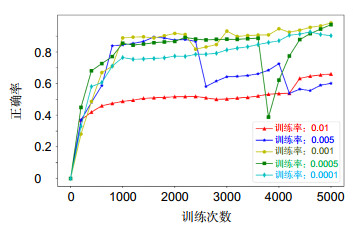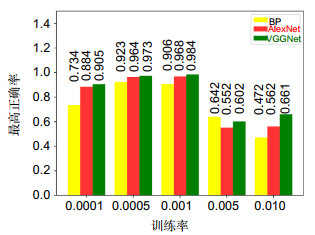-
摘要
针对电力系统中存在的难以检测运营中的绝缘子劣化问题,本文在深入分析卷积神经网络模型的原理和结构的基础上,运用卷积神经网络算法对绝缘子劣化程度进行评估。通过绝缘子工频闪络试验使其产生无放电、弱放电、强放电三种状态,并使用紫外成像仪采集不同放电状态下的绝缘子紫外图像构建紫外图像样本库。利用VGGNet框架神经网络算法对样本进行分类训练和状态预测评估,最终达到判断绝缘子是否劣化的目的。由实验结果可知,该算法准确率高达98.4%,在绝缘子劣化检测上有宽广的应用前景,并为其他电力设备的可靠性检测提供了思路。

Abstract
In the power system, it is difficult to detect the insulator's deterioration in operation. Aiming at this problem, this thesis applies the convolution neural network algorithm to evaluate the insulator's deterioration degree based on the deep analysis of the principle and structure of the convolution neural network model. Firstly, the power frequency flashover test was conducted on the insulator to produce three states as follows: no discharge, weak discharge, and strong discharge. Moreover, the Ultraviolet imager was applied to collect the insulator's ultraviolet images in different discharge state to establish the ultraviolet images sample library. Subsequently, the VGGNet framework neural network algorithm was applied to perform the classification training and the state-prediction evaluation on the samples so as to eventually achieve the purpose of judging whether the insulator is degraded. From the experimental results, it can be seen that the accuracy rate of the algorithm is as high as 98.4%, which has broad application prospects in the insulator's degradation detection. Furthermore, it provides a mentality for the reliability detection of other power equipments.
-
Key words:
- CNN /
- ultraviolet discharge /
- nondestructive testing /
- insulator
-
Overview

Overview: The electricity system structure of our country is very complicated. To maintain the stability and the reliability of the electricity system, we need to have all kinds of reliable and stable equipments, and the insulator is one of them. Insulators are devices which are installed between the conductors of different potentials or conductors and the grounding components. They can also tolerate the effect of voltage and mechanical stress. The main function of the insulators is to realize electrical insulation and mechanical fastening. They are important devices of the electricity system. Whether the insulation function of the insulator is in good condition will influence the lifespan and safely running of the whole circuit. Therefore, how to test the deterioration level of the working insulator is a substantial research topic. What this paper works on is using UV image camera to collect ultraviolet images of the insulators under different discharging states and building an ultraviolet images sample bank. This paper uses the VGGNET framework neural network algorithm to classify the training and statement, and forecast assess the sample in order to estimate whether insulators are deteriorated, and contrast and analysis to other algorithms. VGGNET model: by repeatedly stacking the convolution kernel whose receptive field is 3×3, the non-linearity of the model is improved, so that it has stronger feature learning ability and better recognition effect for the image data with small feature difference of insulator UV discharge images. In addition, it is better than using the large-scale coil. Compared with the product kernel, it effectively reduces the number of parameters and makes it have higher training efficiency. According to the results of experiment, the accuracy of this algorithm is high up to 98.4%. It has the advantages such as high accuracy, short training time, and the generalization of the model is good. It will have broad using prospects in the deterioration test of the insulators, and it also provides a new way to the reliability testing of other electrical devices. With the development of UAV and communication technology, the UAV with high mobility, high control ability, and other characteristics has become an ideal power inspection platform. The emergence of the 5G technology makes it possible to transmit high-quality images in real time. Taking UAV platform as carrier, equipped with UV imager, transmitting UV image in real time through 5G technology, and using non-destructive detection algorithm to detect the fault points will become possible. Therefore, the research in this paper has broad application prospects, and we will explore further in the future.
-

-
表 1 VGGNet模型参数
Table 1. VGGNet model parameters
层数 层名 卷积核参数 输出参数 数量 尺寸 步长 长度 宽度 深度 0 输入层 - - - 224 224 3 1 卷积层 64 3 1 224 224 64 2 卷积层 64 3 1 224 224 64 3 池化层 - 2 2 112 112 64 4 卷积层 128 3 1 112 112 128 5 卷积层 128 3 1 112 112 128 6 池化层 - 2 2 56 56 128 7 卷积层 256 3 1 56 56 256 8 卷积层 256 3 1 56 56 256 9 卷积层 256 3 1 56 56 256 10 池化层 - 2 2 28 28 256 11 卷积层 512 3 1 28 28 512 12 卷积层 512 3 1 28 28 512 13 卷积层 512 3 1 28 28 512 14 池化层 - 2 2 14 14 512 15 卷积层 512 3 1 14 14 512 16 卷积层 512 3 1 14 14 512 17 卷积层 512 3 1 14 14 512 18 池化层 - 2 2 7 7 512 19 全连接层 - - - 1 1 4096 20 全连接层 - - - 1 1 4096 21 全连接层 - - - 1 1 1000 22 输出层 - - - 1 1 3 表 2 不同训练率下正确率对比
Table 2. Comparison of correctness rates under different training rates
训练次数 训练率 0.01 0.005 0.001 0.0005 0.0001 1000 0.488 0.843 0.883 0.855 0.765 2000 0.517 0.876 0.913 0.864 0.773 3000 0.503 0.635 0.935 0.883 0.812 4000 0.537 0.724 0.947 0.621 0.873 5000 0.661 0.602 0.984 0.973 0.905 表 3 不同训练率和训练次数下的标准差
Table 3. Mean square deviation at different training rates and numbers
训练次数 训练率 0.01 0.005 0.001 0.0005 0.0001 1000 1.2521 0.3132 0.2080 0.8203 0.5301 2000 1.3352 0.1335 0.1389 0.1384 1.0306 3000 0.7846 0.6437 0.1241 0.1618 0.5220 4000 0.6768 0.6461 0.0875 0.1061 0.4010 5000 0.5355 0.5675 0.0712 0.1131 0.3699 表 4 算法对比
Table 4. Algorithm comparison
算法 准确率/% 训练耗时/s 测试耗时/s VGGNet 98.4 274.37 0.0013 BOA-SVM 94.0 883.79 0.1174 RBFNN 92.5 2104.51 0.0169 DBN 97.1 1863.94 0.0471 -
参考文献
[1] 吕志宁. 输电线路常见故障分析与检测方法综述[J]. 自动化与仪器仪表, 2020(1): 161–164, 168. https://www.cnki.com.cn/Article/CJFDTOTAL-ZDYY202001041.htm
Lv Z N. A survey of common faults analysis and detection methods for transmission line[J]. Autom Instrum, 2020(1): 161–164, 168. https://www.cnki.com.cn/Article/CJFDTOTAL-ZDYY202001041.htm
[2] 黄云程, 郑云海, 许萍萍. 应用红外检测技术评估复合绝缘子劣化状态[J]. 电工电气, 2019(6): 48–52. https://www.cnki.com.cn/Article/CJFDTOTAL-JSDQ201906014.htm
Huang Y C, Zheng Y H, Xu P P. Degradation state of composite insulator evaluated by infrared detection technology[J]. Electrotech Electr, 2019(6): 48–52. https://www.cnki.com.cn/Article/CJFDTOTAL-JSDQ201906014.htm
[3] 田治仁, 金立军. 基于彩色可见光图像的绝缘子污秽等级判别[J]. 电工电能新技术, 2015, 34(9): 70–74. doi: 10.3969/j.issn.1003-3076.2015.09.012
Tian Z R, Jin L J. Detection of insulator contamination grades based on digital image processing[J]. Adv Technol Electr Eng Energy, 2015, 34(9): 70–74. doi: 10.3969/j.issn.1003-3076.2015.09.012
[4] 马立新, 周小波, 朱润, 等. 紫外检测电晕放电强度量化分级[J]. 光电工程, 2016, 43(1): 1–5. doi: 10.3969/j.issn.1003-501X.2016.01.001
Ma L X, Zhou X B, Zhu R, et al. The quantitative classification of corona discharge intensity of UV detection[J]. Opto-Electron Eng, 2016, 43(1): 1–5. doi: 10.3969/j.issn.1003-501X.2016.01.001
[5] Asimakopoulou G E, Kontargyri V T, Tsekouras G J, et al. Artificial neural network optimisation methodology for the estimation of the critical flashover voltage on insulators[J]. IET Sci Meas Technol, 2009, 3(1): 90–104. doi: 10.1049/iet-smt:20080009
[6] 裴少通. 基于红外紫外成像检测技术的绝缘子运行状态分析与评估[D]. 北京: 华北电力大学(北京), 2019.
Pei S T. Analysis and evaluation of insulator operation status based on infrared and ultraviolet imaging detection technology[D]. Beijing: North China Electric Power University (Beijing), 2019.
[7] 左国玉, 马蕾, 徐长福, 等. 基于跨连接卷积神经网络的绝缘子检测方法[J]. 电力系统自动化, 2019, 43(4): 101–106. https://www.cnki.com.cn/Article/CJFDTOTAL-DLXT201904013.htm
Zuo G Y, Ma L, Xu C F, et al. Insulator detection method based on cross-connected convolutional neural network[J]. Autom Electr Power Syst, 2019, 43(4): 101–106. https://www.cnki.com.cn/Article/CJFDTOTAL-DLXT201904013.htm
[8] Woon W L, El-Hag A, Harbaji M. Machine learning techniques for robust classification of partial discharges in oil–paper insulation systems[J]. IET Sci Meas Technol, 2016, 10(3): 221–227. doi: 10.1049/iet-smt.2015.0076
[9] Pei S T, Liu Y P, Ji X X, et al. UV-flashover evaluation of porcelain insulators based on deep learning[J]. IET Sci Meas Technol, 2018, 12(6): 770–776. doi: 10.1049/iet-smt.2017.0465
[10] Czajka A, Bowyer K W, Krumdick M, et al. Recognition of image-orientation-based iris spoofing[J]. IEEE Trans Inf For Secur, 2017, 12(9): 2184–2196. doi: 10.1109/TIFS.2017.2701332
[11] Chen Y, Xu Y. Detection and localization of untwisted strands in transmission lines using cascaded shape filtering and color filtering[C]//2015 IEEE Workshop on Signal Processing Systems (SIPS), 2015: 1–6.
[12] Zhang Z J, Zhang W, Zhang D D, et al. Comparison of different characteristic parameters acquired by UV imager in detecting corona discharge[J]. IEEE Trans Dielectr Electr Insul, 2016, 23(3): 1597–1604. doi: 10.1109/TDEI.2016.005499
[13] Wang S H, Lv F C, Liu Y P. Estimation of discharge magnitude of composite insulator surface corona discharge based on ultraviolet imaging method[J]. IEEE Trans Dielectr Electr Insul, 2014, 21(4): 1697–1704. doi: 10.1109/TDEI.2014.004358
[14] 林锦发. 基于深度学习的遥感图像语义分割方法研究[D]. 广州: 广东工业大学, 2019.
Lin J F. Research on semantic segmentation of remote sensing image based on deep learning[D]. Guangzhou: Guangdong University of Technology, 2019.
[15] 裴斐. 基于深度卷积神经网络的图像风格迁移系统研究[D]. 银川: 宁夏大学, 2019.
Pei F. Research on image style migration system based on deep convolutional neural network[D]. Yinchuan: Ningxia University, 2019.
[16] 裴少通, 刘云鹏, 陈同凡, 等. 基于BOA-SVM的劣化绝缘子红外图谱诊断方法[J]. 电测与仪表, 2018, 55(24): 11–16. https://www.cnki.com.cn/Article/CJFDTOTAL-DCYQ201824003.htm
Pei S T, Liu Y P, Chen T F, et al. Infrared spectrum diagnosis method of deteriorated insulators based on BOA-SVM[J]. Electr Meas Instrum, 2018, 55(24): 11–16. https://www.cnki.com.cn/Article/CJFDTOTAL-DCYQ201824003.htm
-
访问统计


 E-mail Alert
E-mail Alert RSS
RSS

 下载:
下载:









